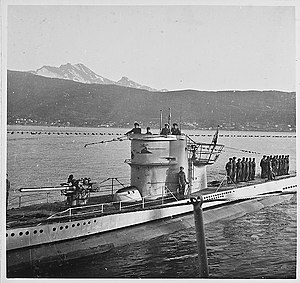
Summary
The 8.8 cm SK C/35[Note 1] was a German naval gun used in World War II.
| 8.8 cm SK C/35 | |
|---|---|
 A gun aboard U-251 in 1942 | |
| Type | Naval gun |
| Place of origin | |
| Service history | |
| In service | 1939–1945 |
| Used by | |
| Wars | World War II |
| Production history | |
| Designed | 1935–1938 |
| Specifications | |
| Mass | 776 kilograms (1,711 lb) |
| Length | 3.985 meters (13 ft 0.9 in) |
| Barrel length | 3.731 meters (12 ft 2.9 in) (bore length) |
| Shell | Fixed Brass Casing: 15 kilograms (33 lb) |
| Shell weight | 9–10.2 kilograms (20–22 lb) |
| Caliber | 88 millimeters (3.5 in) |
| Breech | vertical sliding-block |
| Elevation | +30° to −10°[1] |
| Traverse | 360° |
| Muzzle velocity | 700 m/s (2,300 ft/s) |
| Maximum firing range | 11,950 metres (13,070 yd) at +30°[1] |
Description edit
The 8.8 cm SK C/35 gun weighed 776 kilograms (1,711 lb) and had an overall length of 3.985 meters (13 ft 0.9 in) with a vertical sliding-block breech. The gun fired a 9.5 kg (21 lb) projectile 88 mm in diameter, and the barrel is sometimes described as 45 caliber. A 2.82 kg (6.2 lb) propellent charge produced muzzle velocity of 700 m/s (2,300 ft/s) with nose-fuzed high explosive and high explosive incendiary projectiles (with or without tracer). Useful life expectancy was 12,000 effective full charges (EFC) per barrel.[1]
Ammunition edit
Ammunition was of a fixed type with a Complete Round Weight of 15 kg (33 lb) and a projectile length of around 355 mm (14.0 in). The gun was able to fire:
- Armor Piercing (AP) - 10.2 kg (22 lb)
- High Explosive (HE) - 9 kg (20 lb)
- Illumination (ILLUM) - 9.4 kg (21 lb)
The High Explosive (HE) round has a muzzle velocity of 700 m/s (2,300 ft/s).[2]
History edit
edit
This was the standard deck gun mounted forward of the conning tower in Type VII boats, although a few substituted a high-angle 8.8 cm SK C/30 naval gun for anti-aircraft defense.[1] The SK C/35 was designed for the prototype VIIA boats of 1935 with a nominal ammunition allowance of 220 rounds. During the early war years, these guns were used to encourage surrender of independently routed merchant ships or to sink ships damaged by torpedoes.[3] Some of these guns were later removed from U-boats for mounting aboard minesweepers and submarine chasers after unshielded deck guns proved impractical in action against Defensively Equipped Merchant Ships and escorted trade convoys.[4]
See also edit
Notes edit
- ^ SK - Schnelladekanone (quick loading cannon); C - Construktionsjahr (year of design).
References edit
- ^ a b c d Campbell 2002, p. 251.
- ^ DiGiulian 2022.
- ^ Blair 1996, p. 63.
- ^ Lenton 1976, pp. 126–127.
References edit
- Blair, Clay (1996). Hitler's U-Boat War: The Hunters 1939–1942. New York: Random House. ISBN 0-394-58839-8.
- Campbell, John (2002). Naval Weapons of World War Two. London: Conway Maritime Press. ISBN 0-87021-459-4.
- Gander, Terry; Chamberlain, Peter (1979). Weapons of the Third Reich: An Encyclopedic Survey of All Small Arms, Artillery and Special Weapons of the German Land Forces 1939–1945. New York: Doubleday. ISBN 0-385-15090-3.
- Hogg, Ian V. (1997). German Artillery of World War Two (2nd corrected ed.). Mechanicsville, PA: Stackpole Books. ISBN 1-85367-480-X.
- Lenton, H.T. (1976). German Warships of the Second World War. New York: Arco. ISBN 0-668-04037-8.
- Rolf, Rudi (1998). Der Atlantikwall: Bauten der deutschen Küstenbefestigungen 1940–1945. Osnabrück: Biblio. ISBN 3-7648-2469-7.
- Rolf, Rudi (2004). A Dictionary on Modern Fortification: An Illustrated Lexicon on European Fortification in the Period 1800–1945. Middleburg, Netherlands: PRAK.
External links edit
- DiGiulian, Tony (December 27, 2022). "Germany 8.8 cm/45 (3.46") SK C/35". NavWeaps. Naval Weapons, Naval Technology and Naval Reunions. Archived from the original on June 10, 2023. Retrieved September 15, 2023.


